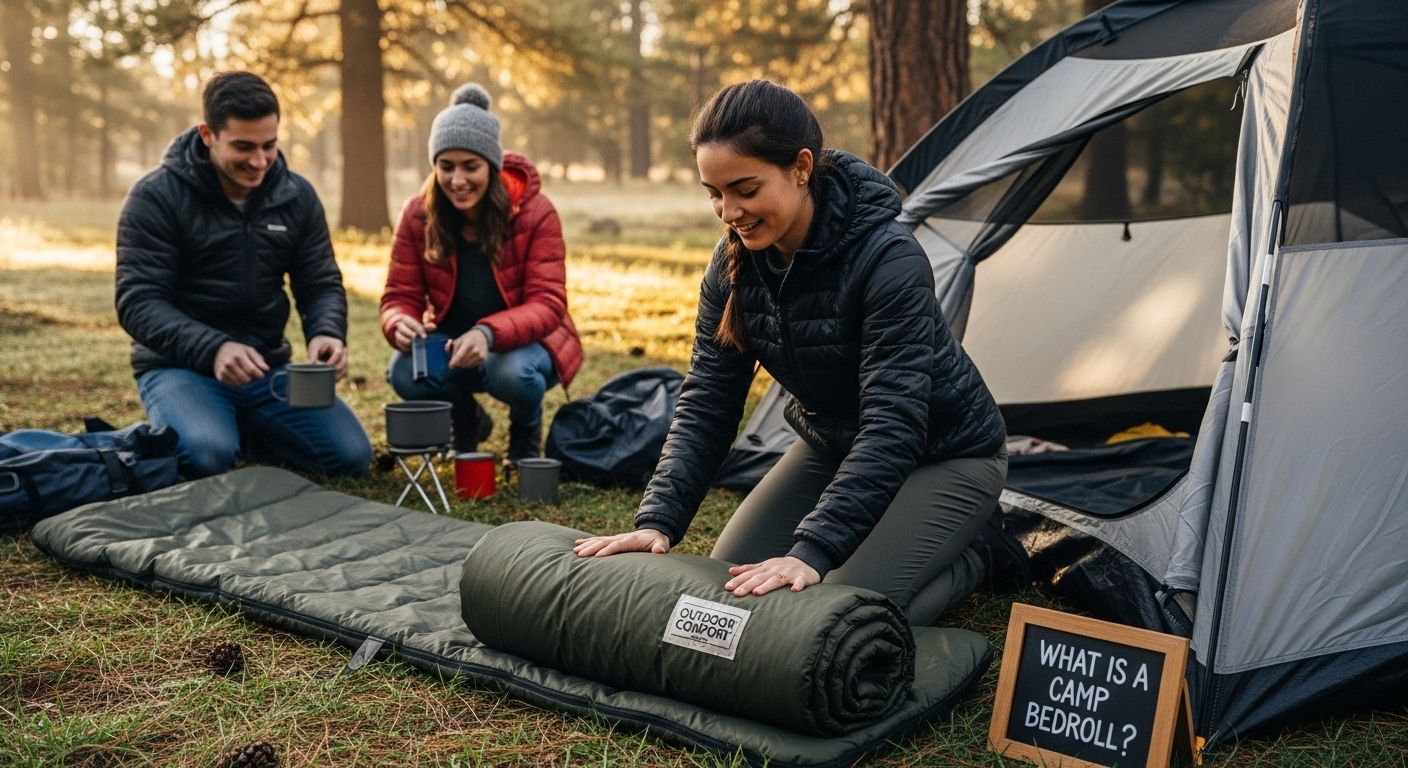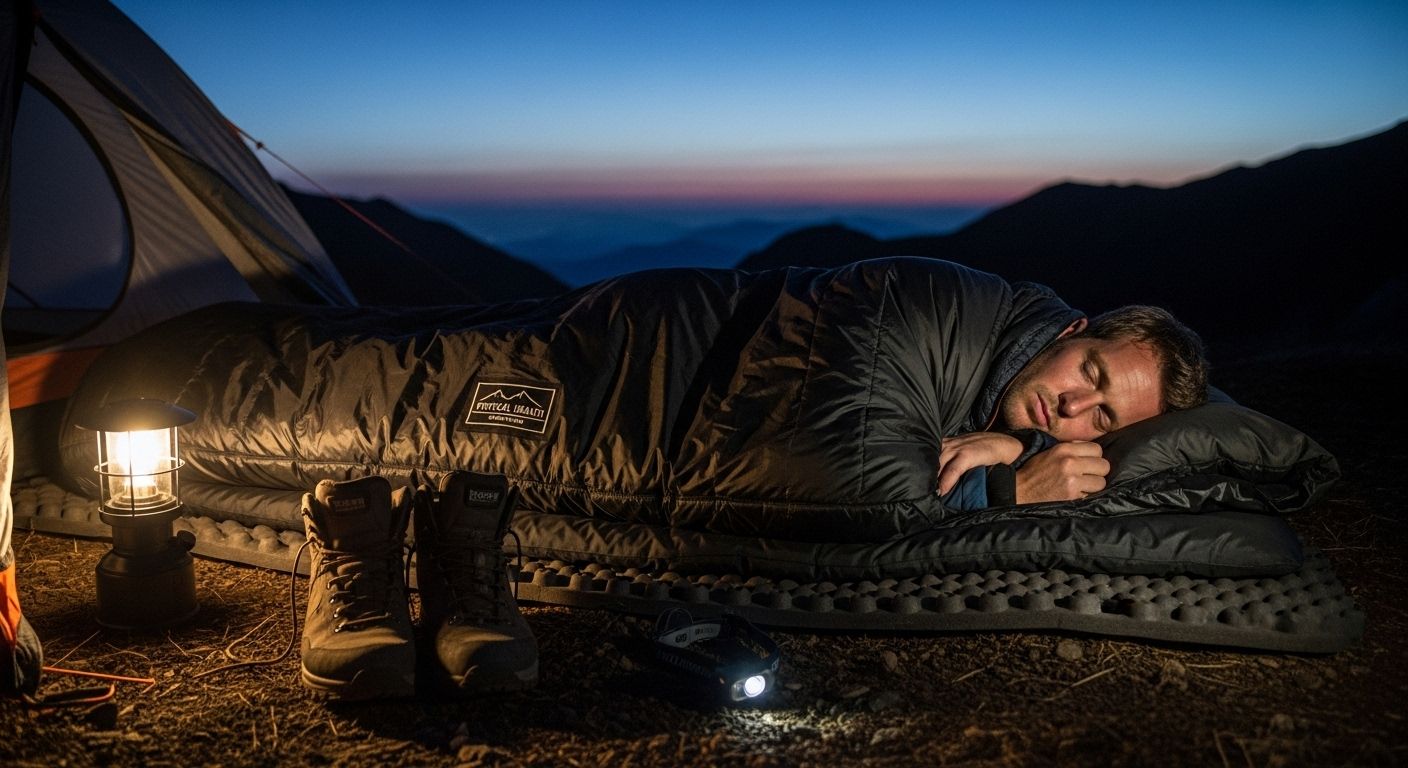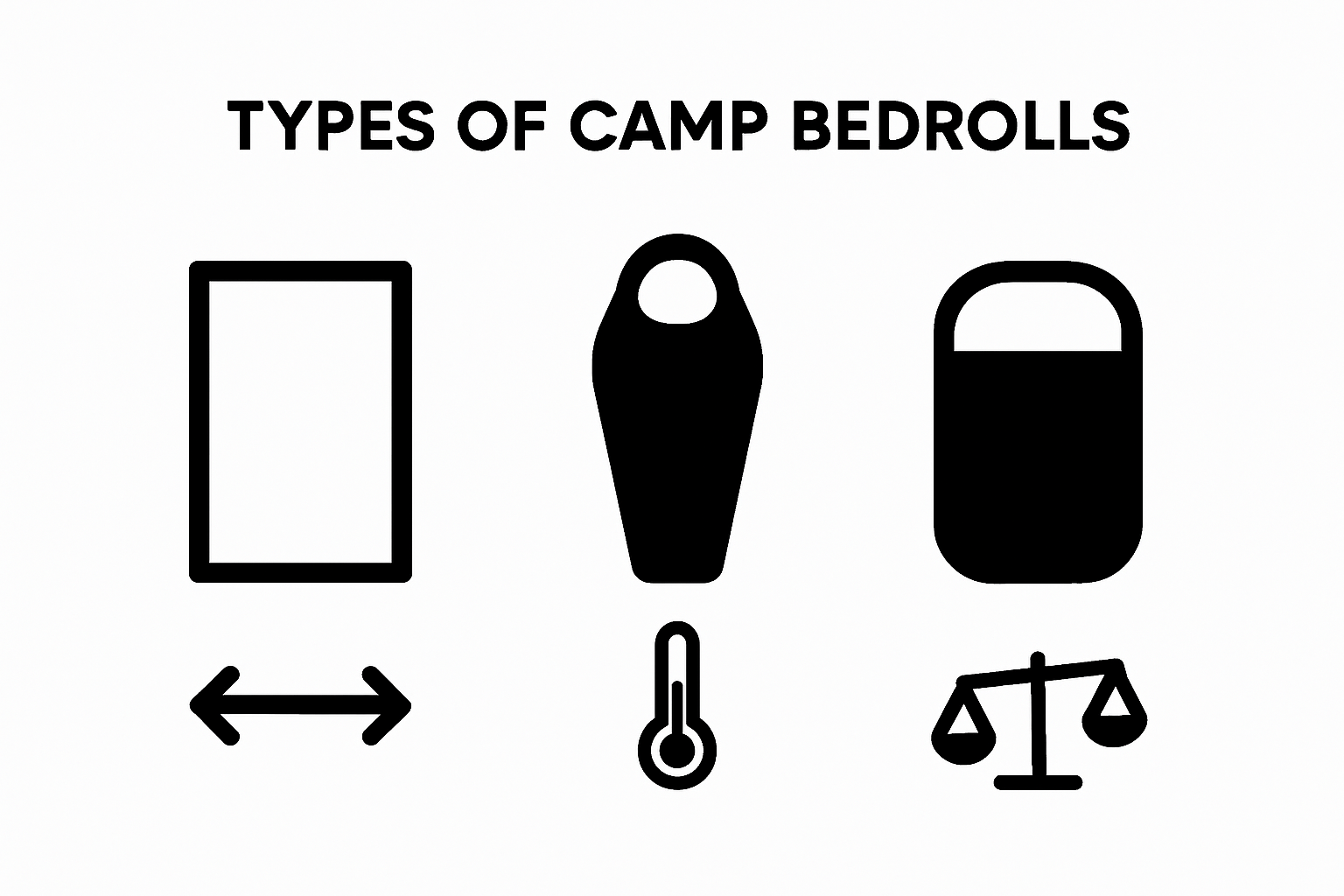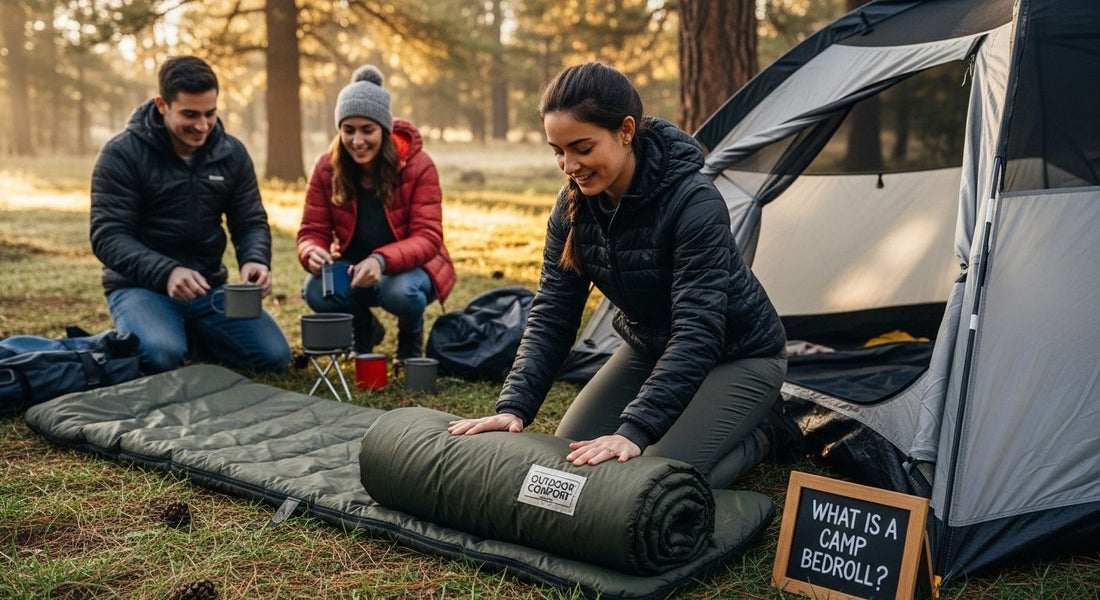
Camping might seem like a simple escape into nature, but your sleep setup can make or break the whole trip. Most people think a rough night outdoors is just part of the deal, yet a single piece of gear called a camp bedroll can flip the story. Some modern bedrolls use advanced insulation that keeps you warm even when wet, with synthetic materials outperforming traditional down in humid conditions. The best surprise is that these aren’t just blankets with straps, they pack in layers of smart design meant for comfort, recovery, and even your peace of mind out in the wild.
Table of Contents
- Defining A Camp Bedroll: What It Is And Its Components
- The Importance Of A Camp Bedroll For Outdoor Comfort
- Understanding The Different Types Of Camp Bedrolls
- Materials And Design: How A Camp Bedroll Works
- Real-World Applications: Using A Camp Bedroll In Various Settings
Quick Summary
| Takeaway | Explanation |
|---|---|
| A camp bedroll provides essential outdoor comfort | It ensures warmth and protection, crucial for a restful sleep in various environments. |
| Layer design enhances thermal regulation | Each layer serves a specific purpose, managing heat and moisture to create a comfortable microclimate. |
| Different types cater to specific needs | Options like rectangular and mummy-style bedrolls suit various temperature and space preferences. |
| Investing in quality impacts performance | A well-designed bedroll improves recovery and energy levels, enhancing the camping experience. |
| Applicable in diverse professional scenarios | Beyond camping, they are vital for wildland firefighting, search and rescue, and military missions. |
Defining a Camp Bedroll: What It Is and Its Components
A camp bedroll represents a fundamental piece of outdoor sleeping equipment designed to provide comfort and protection during camping adventures. More than just a simple blanket or sleeping bag, a camp bedroll is a comprehensive sleeping system that combines multiple elements to ensure warmth, insulation, and portability for outdoor enthusiasts.
Core Components of a Camp Bedroll
Typically, a camp bedroll consists of several essential components that work together to create a comfortable sleeping environment. These components include:
- Outer Layer: A durable, water-resistant material that protects against moisture and environmental elements
- Insulation Layer: Typically made of materials like wool or synthetic fabrics that retain body heat
- Inner Lining: A soft, comfortable material that provides direct contact with the sleeper
According to the Library of Congress historical records, bedrolls have been a critical component of outdoor equipment for military and civilian use since the early 20th century. These versatile sleeping systems were originally designed to provide soldiers and explorers with a compact, portable sleeping solution that could withstand harsh environmental conditions.
Design and Functionality
The primary purpose of a camp bedroll is to offer a lightweight, compact sleeping solution that can be easily transported and quickly deployed in various outdoor settings. Unlike traditional sleeping bags, camp bedrolls often feature a more flexible design that allows for greater adaptability in different camping scenarios.
A well-constructed camp bedroll provides several key advantages for outdoor enthusiasts. Portability is perhaps the most significant benefit, as these sleeping systems can be rolled, compressed, and carried with minimal effort. The compact nature means backpackers, hikers, and campers can easily include a bedroll in their gear without adding substantial weight to their equipment.
The materials used in modern camp bedrolls have evolved significantly, incorporating advanced synthetic fabrics and innovative insulation technologies. These improvements ensure better temperature regulation, moisture management, and overall comfort compared to traditional bedrolls used in previous generations.
Whether you are a weekend camper or a seasoned outdoor adventurer, understanding the components and design of a camp bedroll can help you make informed decisions about your outdoor sleeping gear and ensure a comfortable experience in various environmental conditions.
This table summarizes the core components found in most camp bedrolls, along with their specific functions in optimizing outdoor sleep quality.
| Component | Function |
|---|---|
| Outer Layer | Shields against moisture and environmental elements |
| Insulation Layer | Retains body heat and prevents heat loss |
| Inner Lining | Provides comfort and softness against the skin |
The Importance of a Camp Bedroll for Outdoor Comfort
Outdoor comfort represents more than just a luxury during camping trips it is a critical factor in ensuring safety, physical recovery, and overall enjoyment of wilderness experiences. A camp bedroll plays a pivotal role in creating a comfortable sleeping environment that protects campers from harsh environmental conditions and supports optimal rest.
Physical Health and Recovery
Quality sleep is essential for maintaining physical and mental performance during outdoor activities.
 A well-designed camp bedroll provides several crucial health benefits:
A well-designed camp bedroll provides several crucial health benefits:
- Thermal Regulation: Helps maintain body temperature in fluctuating outdoor environments
- Pressure Distribution: Reduces physical stress on muscles and joints during sleep
- Moisture Management: Prevents heat loss and keeps the body dry in challenging conditions
According to research from the American Hiking Society, proper sleeping equipment is fundamental to maintaining energy levels and preventing fatigue during extended outdoor adventures. The right camp bedroll can significantly impact a camper’s ability to recover and perform in challenging wilderness settings.
Psychological Comfort and Mental Well-being
Beyond physical considerations, a camp bedroll provides critical psychological comfort. Feeling secure and warm in an unfamiliar outdoor environment reduces stress and anxiety, enabling campers to relax and fully immerse themselves in their wilderness experience. The psychological reassurance of a comfortable sleeping setup cannot be understated, as it transforms potentially challenging outdoor conditions into an opportunity for rest and rejuvenation.
The design of modern camp bedrolls takes into account not just thermal protection, but also the psychological need for a personal, safe sleeping space. By creating a compact, portable sanctuary, these sleeping systems help outdoor enthusiasts feel more connected to their environment while maintaining a sense of personal comfort and security.
Whether you are a weekend camper or a seasoned backpacker, investing in a high-quality camp bedroll is an investment in your outdoor experience. It represents the difference between merely surviving in the wilderness and truly enjoying every moment of your adventure, ensuring that you wake up refreshed, energized, and ready to explore.
Understanding the Different Types of Camp Bedrolls
Camp bedrolls come in a variety of designs, each tailored to meet specific outdoor sleeping requirements and environmental conditions. Understanding these variations helps outdoor enthusiasts select the most appropriate sleeping solution for their particular camping needs.
Fundamental Bedroll Categories
Camp bedrolls can be broadly classified into several distinct categories, each offering unique features and benefits
 :
:
- Rectangular Bedrolls: Provide maximum space and flexibility for movement
- Mummy-Style Bedrolls: Offer superior thermal efficiency and compact design
- Semi-Rectangular Bedrolls: Balance between space and thermal protection
According to research from the American Hiking Society, the selection of a bedroll type depends on multiple factors including anticipated temperature, weight considerations, and intended camping environment.
Material and Insulation Variations
The materials used in camp bedrolls significantly impact their performance and suitability for different outdoor scenarios. Synthetic insulation offers excellent moisture resistance and maintains thermal properties even when damp, making it ideal for humid or wet environments. In contrast, down insulation provides exceptional warmth-to-weight ratio, compressing more easily and delivering superior thermal efficiency in dry, cold conditions.
Modern camp bedrolls incorporate advanced technologies that enhance their functionality.
Below is a table comparing the main types of insulation used in camp bedrolls, summarizing their distinct characteristics and optimal usage environments.
| Insulation Type | Key Characteristics | Best For |
|---|---|---|
| Synthetic | Moisture-resistant, dries quickly | Humid or wet environments |
| Down | Excellent warmth-to-weight ratio | Dry, cold environments |
| Wool | Naturally insulating, even when damp | Traditional and varied climates |
| Advanced Synthetics | Lightweight, retains heat when wet | Versatile modern applications |
| Lightweight, moisture-wicking fabrics and specialized thermal reflective linings have transformed these sleeping systems from basic protective coverings to sophisticated comfort solutions that adapt to changing environmental conditions. |
The evolution of camp bedroll design reflects a deep understanding of outdoor enthusiasts’ diverse needs.
Whether you are a minimalist backpacker seeking ultralight solutions or a car camper prioritizing spacious comfort, the contemporary market offers specialized bedrolls that cater to virtually every camping preference and performance requirement.
Materials and Design: How a Camp Bedroll Works
The intricate engineering behind camp bedrolls combines advanced material science with practical design principles to create a comprehensive sleeping solution for outdoor environments. Understanding the mechanics of how these systems function reveals the sophisticated approach to thermal management, comfort, and protection.
Thermal Regulation Mechanics
Camp bedrolls operate through a complex interaction of materials designed to manage heat exchange and moisture. The core functionality revolves around creating a microclimate that insulates the sleeper from external temperature variations:
- Insulation Layer: Traps body heat and prevents heat loss
- Outer Shell: Blocks wind and repels external moisture
- Inner Lining: Manages moisture and provides comfort against skin
According to research documenting historical bedroll designs, the fundamental principles of thermal protection have remained consistent, though materials and technologies have dramatically evolved.
Structural Design Principles
Layered construction is the fundamental approach in modern camp bedroll design. Each layer serves a specific purpose, working in concert to create an effective sleeping environment. The outer shell typically features water-resistant and wind-blocking properties, while the inner layers focus on moisture management and heat retention.
Advanced camp bedrolls incorporate sophisticated material technologies that go beyond traditional fabric limitations. Synthetic materials with specialized weaves and treatments enable unprecedented levels of breathability, temperature regulation, and compact storage. Innovations like moisture-wicking fabrics and reflective thermal linings transform these sleeping systems from basic protective coverings into high-performance comfort solutions.
The engineering behind camp bedrolls represents a remarkable intersection of outdoor necessity and technological innovation. By understanding the intricate design principles and material interactions, outdoor enthusiasts can appreciate these systems not just as sleeping equipment, but as carefully crafted solutions engineered to provide comfort and protection in challenging environmental conditions.
Real-World Applications: Using a Camp Bedroll in Various Settings
Camp bedrolls serve far more than recreational purposes, providing critical sleeping solutions across diverse environments and professional scenarios. Their adaptability makes them essential equipment for individuals operating in challenging outdoor conditions where comfort and thermal protection are paramount.
Professional and Emergency Applications
Beyond traditional camping, camp bedrolls play crucial roles in professional and emergency contexts where reliable sleeping systems can mean the difference between safety and vulnerability:
- Wildland Firefighting: Provides critical rest during extended deployment periods
- Search and Rescue Operations: Enables rapid deployment in remote locations
- Military Field Missions: Supports personnel functioning in extreme environmental conditions
According to research from the U.S. Forest Service, specialized sleeping systems designed for professional use must meet rigorous performance standards addressing thermal efficiency, portability, and durability.
Specialized Outdoor Environment Adaptations
Thermal versatility represents the most significant advantage of modern camp bedrolls. Innovative designs accommodate extreme temperature variations, from arctic expeditions to desert environments, by incorporating advanced material technologies that dynamically respond to changing atmospheric conditions.
Professional outdoor practitioners understand that a camp bedroll is not merely a sleeping accessory but a critical piece of survival equipment. Specialized variants are engineered to provide optimal performance in specific environments, whether navigating alpine terrains, conducting scientific research in remote locations, or supporting emergency response teams.
The complexity of contemporary camp bedroll design reflects a profound understanding of human physiological needs in challenging outdoor settings. By integrating sophisticated material science with practical engineering principles, these sleeping systems have evolved from basic protective coverings to comprehensive comfort and survival solutions that empower individuals to rest effectively in virtually any environmental condition.
Upgrade Your Outdoor Comfort with Hazli Collection
Are you tired of sacrificing comfort for portability every time you camp? After reading about the essential components of a camp bedroll and the struggle many face to balance warmth, durability, and sleep quality outdoors, you know that true outdoor relaxation starts with the right gear. At Hazli Collection, you do not need to choose between lightweight design and a restful night’s sleep. Our lineup of memory foam camping mattresses is crafted to ensure you wake refreshed and supported, whether you are a casual camper or an all-season adventurer. Imagine transforming rough ground into your own comfortable sanctuary every night spent outdoors.

Experience the real difference by browsing our curated selection of outdoor sleep solutions at Hazli Collection. See how our practical products solve the same challenges discussed in this article by delivering portable comfort, advanced insulation, and water-resistant protection — all tailored for demanding outdoor conditions. Give yourself the peace of mind and true rest every camper deserves. Shop now and elevate your next adventure with the bedroll technology you just learned about.
Frequently Asked Questions
What is a camp bedroll?
A camp bedroll is a portable sleeping system designed for outdoor use, consisting of an outer layer for protection, insulation to retain warmth, and an inner lining for comfort, ensuring a good night’s sleep in various environmental conditions.
What are the main components of a camp bedroll?
A typical camp bedroll includes three main components: an outer layer made of durable, water-resistant material, an insulation layer usually made from wool or synthetic fabrics, and an inner lining that provides comfort and softness against the sleeper’s skin.
How does a camp bedroll differ from a sleeping bag?
Unlike a sleeping bag, which typically has a fixed shape, a camp bedroll often features a more flexible design, allowing for more movement. Bedrolls also emphasize portability and adaptability for different camping scenarios and may offer better thermal regulation based on their construction.
What types of insulation are used in camp bedrolls?
Camp bedrolls usually feature two main types of insulation: synthetic insulation, which is moisture-resistant and works well in humid conditions, and down insulation, known for its excellent warmth-to-weight ratio, making it ideal for dry, cold environments.

